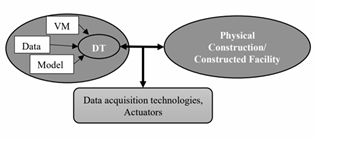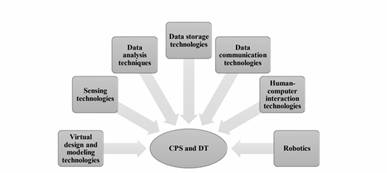By Tarun Vats, Sudhakar Kumar
Cyber-Physical System
Cyber-physical systems (CPSs) or intelligent systems are computer systems that use computer-based algorithms for controlling or monitoring machines. Cyber-physical systems are composed of both physical and software components, enabling them to function at diverse spatiotemporal scales, exhibit distinct behavioral modalities, and interact with one another in various contexts.[1, 11-13]
Digital Twin
A Digital Twin(DT) is a unified repository of all data (operational data, test results, etc.), models (engineering models, design drawings, analyses, etc.), and other information (orders, inspections, requirements, etc.) generated during the lifecycle of a physical asset that maximizes economic potential. The Digital Twin’s job is to predict and improve performance. Simulation and/or data-based methods are employed for this goal.[8]
Comparison of Cyber Physical System and Digital Twin

Key features
In terms of idea, DT might be regarded as a subset of CPS because it also requires employing computer resources to integrate physical components or systems with their virtual representations [10]. As shown in Figure 1, CPS and DTs can exist with a ‘physical-to-cyber’ and ‘cyber-to-physical’ bridge. Data reflecting the status and condition of the physical system is gathered by using sensing and data gathering technologies. Each idea, on the other hand, has a slightly different ‘cyber-to-physical’ connection. In DTs, controls are done by the use of models that foresee future conditions and threats, allowing for timely actions (also referred to as passive control). CPS control can be active or passive. Physical devices, like actuators, are employed to govern the physical system state in inactive control.

Next-generation CPS and DT in construction
CPS and DTs strive to achieve two-way coordination and communication between digital models and the physical construction facility in the context of construction (Fig. 2). If there is a two-way mapping (dynamic mapping) with the actual construction facility, the virtual model is referred to as the DT. The DT’s capability can be enhanced through continuous data collecting and integration. CPS can be considered as the interaction and convergence required between a physical construction and its DT, given the similarities in the twinning criteria of both concepts. In this situation, DT would be essential for the creation of a CPS. A CPS like this would aid the building sector in making better and more efficient decisions.

Technologies needed to be enabled
Since their launch, the popularity of both DT and CPS has skyrocketed. Virtual modeling platforms, data collection, storage, sensing technologies, data communication technologies, IoTs, robotics, and human-computer interface technologies (Fig. 3) have all contributed to the industry’s success [14-16].

Application areas
- Teleoperation robots used in the installation of drywall
- Control and tracking of posture [5]
- Preventing worker-machine near-misses [6]
Conclusion
The study of automatic parallelization techniques [7] and compilation techniques [9] resulted in next-generation CPS and DT which offer unique opportunities to improve cyber-physical integration [10]. For optimizing the lifecycle of facilities, there is currently the ability to generate DTs from virtual concept map using previously untapped information from computer architecture and the domain. The benefits in terms of prediction and control are considerable. Virtual design modelling, storage, data analysis, sensing, robotics, and human-computer interaction technologies are all significant enablers. Next-generation CPS and DTs offer a wide range of benefits for improving employee health, productivity, and security, as well as system lifecycle management and workforce competency.
References
[1] Nguyen, G. N. et al (2021) Secure blockchain enabled Cyber–physical systems in healthcare using deep belief network with ResNet model. Journal of Parallel and Distributed Computing, 153, 150-160.
[2] Tao, F., Qi, Q., Wang, L. and Nee, A. (2019). Digital twins and cyber–physical systems toward smart manufacturing and industry 4.0: Correlation and comparison, Engineering, Vol. 5, No. 4, 653-661.
[3] Li, K. C. et al (2020). Recent Advances in Security, Privacy, and Trust for Internet of Things (IoT) and Cyber-Physical Systems (CPS).
[4] Akanmu, A., Anumba, C. and Messner, J. (2013). Scenarios for cyber-physical systems integration in construction, Journal of Information Technology in Construction (ITcon), Vol. 18, No. 12, 240-260.
[5] Statistics, B. O. L. 2020. National Census of Fatal Occupational Injuries in 2019 [Online]. Available: ITcon Vol. 26 (2021), Akanmu et al., pg. 524 https://www.bls.gov/news.release/pdf/cfoi.pdf [Accessed 28th February 2021]
[6] Xu, M., Peng, J., et al. (2021). Multi-agent federated reinforcement learning for secure incentive mechanism in intelligent cyber-physical systems. IEEE Internet of Things Journal.
[7] Sudhakar Kumar, Sunil Kr Singh, Naveen Aggarwal, Kriti Aggarwal, “Evaluation of automatic parallelization algorithms to minimise speculative parallelism overheads: An experiment”, pp 1517-1528, 2021 Journal of Discrete Mathematical Sciences and Cryptography, Volume 24, Issue 5 , Taylor Francis, (2021)
[8] Tarun Vats, Sudhakar Kumar (2022), Digital Twins. Insights2Techinfo, pp. 1
[9] Singh, S. K., Singh, R. K., & BHATIA, M. S. (2010). System level architectural synthesis & compilation technique in reconfigurable computing system. In ESA 2010: proceedings of the 2010 international conference on embedded systems & applications (Las Vegas NV, July 12-15, 2010) (pp. 109-115).
[10] T Saini, S Kumar, T Vats, M Singh (2022), Edge Computing in Cloud Computing Environment: Opportunities and Challenges, http://ceur-ws.org/Vol-3080/17.pdf
[11] Mamta, Gupta, B. B., Li, K. C., Leung, V. C., Psannis, K. E., & Yamaguchi, S. (2021). Blockchain-assisted secure fine-grained searchable encryption for a cloud-based healthcare cyber-physical system. IEEE/CAA Journal of Automatica Sinica, 8(12), 1877-1890.
[12] Xu, M., Peng, J., et al. (2021). Multi-agent federated reinforcement learning for secure incentive mechanism in intelligent cyber-physical systems. IEEE Internet of Things Journal.
[13] Li, K. C., et al. (Eds.). (2020). Recent Advances in Security, Privacy, and Trust for Internet of Things (IoT) and Cyber-Physical Systems (CPS).
[14] Tewari, A., et al. (2017). A lightweight mutual authentication protocol based on elliptic curve cryptography for IoT devices. International Journal of Advanced Intelligence Paradigms, 9(2-3), 111-121.
[15] Lee, E. A. (2008, May). Cyber physical systems: Design challenges. In 2008 11th IEEE international symposium on object and component-oriented real-time distributed computing (ISORC) (pp. 363-369). IEEE.
[16] Fatemidokht, H., Rafsanjani, et al. (2021). Efficient and secure routing protocol based on artificial intelligence algorithms with UAV-assisted for vehicular ad hoc networks in intelligent transportation systems. IEEE Transactions on Intelligent Transportation Systems, 22(7), 4757-4769.